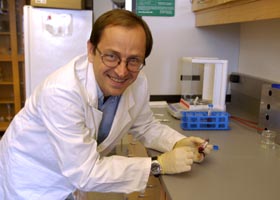|
This is an archived article.
For the latest news, go to the Advance Homepage
For more archives, go to the Advance Archive/Search Page. |
||
|
Blood-Sucking Leeches Are
Blood-letting with leeches, an ancient medical practice that fell into disuse in the 19th century with the growth of pharmaceutical and homeopathic alternatives, has experienced a comeback since the 1980s, when applying leeches to patients after reconstructive surgery was found to help restore blood circulation. Unless pre-treated with antibiotics, a significant number of the patients receiving leech therapy suffer infection caused by Aeromonas veronii, a bacterium that lives in the digestive tract of the leech.
Graf, an assistant professor of microbiology in the Department of Molecular and Cell Biology whose lab is located in the new Biology/Physics Building, is employing molecular and genetic techniques to explain how Aeromonas can cause disease in some hosts, yet live in symbiosis with the medicinal leech, Hirudo medicinalis. The relationship between these bacteria and the leech provides an excellent model for the study of bacterial interactions with other animals, says Graf, whose research is funded by the Swiss National Science Foundation. Most animals live in close association with multiple bacteria. These bacteria play a particularly important role in the digestive tract, where they help stimulate the immune system, protect against pathogens, and provide nutrients. The human gut, for example, has more than 400 species of bacteria. The medicinal leech lends itself to analysis and experimentation, Graf says, because it has only one microorganism - Aeromonas - that can be cultured (or grown) from the main part of its digestive tract. "The ability of Aeromonas veronii ... to colonize hosts in either a cooperative or a pathogenic fashion, and the specificity of its association with Hirudo medicinalis, allow one to address fundamental questions about digestive tract symbioses," Graf wrote in an article published in ASM News, the journal of the American Society for Microbiology, in 2000. Graf, who joined UConn in January 2002 from the Institute for Infectious Diseases of the University of Berne in Switzerland, is currently pursuing three main avenues of inquiry: First, he is trying to understand how the bacteria Aeromonas live in leeches without harming them. A second, related investigation seeks to discover the different requirements for being either a pathogen or a symbiont, as partners in a symbiotic relationship are known. Do the host and the bacterium need to have many different or many similar genes in order to establish a cooperative interaction? What about a pathogenic interaction? Third, he is investigating why the gut of the leech is colonized by a single species of bacteria, and looking for possible anti-microbia l agents that may prevent other microorganisms from colonizing the same area. Graf's work calls for a lot of patience. Leeches take six years to reach maturity, and the adults feed only once every three months or more. Leeches, segmented water worms related to earthworms, are parasites on a variety of animals, sucking the blood of frogs, ducks, cattle, and horses as well as the occasional human. They do not hunt, but instead wait for their prey to present itself. They can survive starvation for many months. When prey does come along, the leech typically feeds for 30 to 45 minutes, gorging until it is full and swelling up "like a fat sausage," says Graf. It can ingest up to five times its body weight in blood. Once full, it drops off its prey. It then excretes most of the water from the blood, and stores the red blood cells for up to six months, digesting them over time. 
The part of the digestive tract where the blood is stored, the crop, is where the Aeromonas bacterium is found. In order to identify which genes the bacteria need to colonize the medicinal leech, Graf is using a technique known as transposon mutagenesis to inactivate single genes. He then tests the resulting mutants for any change in their ability to colonize the host. Although the bacteria and host co-exist in symbiosis, exactly what the benefits of the interaction are to each is still unclear, Graf says. It is generally assumed that Aeromonas benefit from the stable environment and supply of nutrients provided by the leech, but the advantages to the leech are uncertain. Several hypotheses have been proposed: the bacteria may supply essential nutrients to the host by using blood to synthesize vitamins; or they may prevent other, potentially harmful bacteria from invading the leech. One of the experiments Graf is conducting to address some of these questions involves feeding juvenile leeches blood containing antibiotics that inactivate the Aeromonas bacteria, and then monitoring the leeches to see if the absence of bacterial activity affects their growth rate. Another puzzle he is trying to solve is why, although they are able to, the bacteria don't break down the blood cells while they are stored in the crop. Instead, the blood is eventually digested in a different part of the digestive tract, the intestinum. The study of this model system could have wide-ranging implications. "By investigating the cooperative symbiosis of a bacterium that can also cause disease," says Graf, "we will not only learn something about cooperative associations but will also come to understand more about pathogenesis and bacteria-host interactions." |
 he notion of
curing people with blood-sucking leeches may seem
both outmoded and bizarre, but there's nothing
old-fashioned about the techniques Joerg Graf is
using to investigate how leeches can cause disease
as well as help cure patients.
he notion of
curing people with blood-sucking leeches may seem
both outmoded and bizarre, but there's nothing
old-fashioned about the techniques Joerg Graf is
using to investigate how leeches can cause disease
as well as help cure patients.

